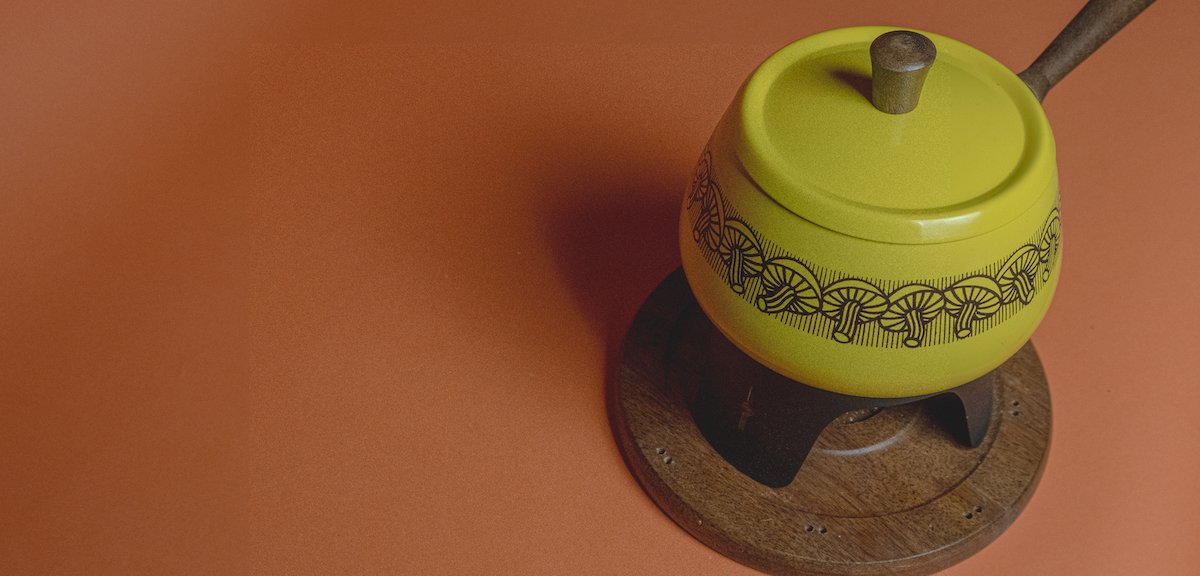HOW TO
FONDUE
The definitive Jasper Hill Farm guide to making immaculate, flavorful fondue every time.
Fondue is a deceptively simple dish with its roots in the French-speaking western lowlands of Switzerland. The name Fondue is the past participle of the verb fondre—“to melt.” Early in its evolution, the dish was known simply as “cheese cooked with wine.” Until the late 19th century, Fondue referred mostly to a French cheese and egg dish. It wasn’t until the 20th century that “cheese fondue” was popularized and became a cozy wintertime staple around the world.
The most important key to successful fondue is forming a consistent emulsion. Dipping our toes back into chemistry 101 a little, we’ll recall that an emulsion is a suspension of two liquids that would normally separate—in this case the fats and trapped moisture within the cheese. We’ve all experienced a cheese that isn’t a good melter, resulting in an oily mess.
To emulsify the proteins, fats, and minerals in the cheese we need wine. Wine contains tartaric acid which is hungry to bind to the calcium that glues together proteins in cheese. By separating the proteins from one another, we free them up to become emulsifying agents resulting in a smooth melted cheese.
Finally, the cheese you choose is going to matter a lot. We recommend using Whitney and or Alpha Tolman as they are going to have more trapped moisture and rich protein structure well-suited to fondue.
WHAT TO (FON) DO
Before you get to melting, prepare all of your ‘dippers.’ We love cubes of crusty bread, charcuterie, roasted potatoes and vegetables, sliced pears and apples, tater tots, pickles, pretzels…the list goes on!
1. GRATE + PREP YOUR CHEESE
In a large bowl, combine your grated cheeses with the cornstarch and toss to coat thoroughly.
2. PREPARE YOUR FONDUE POT
Start warming up your pot, and rub the clove of garlic all around the inside.
If you don’t have an actual fondue pot, scroll down for some ideas for alternatives!
— PRO TIP —
Handheld egg beaters are great for mixing fondue! They’re a little less rough on the wrists than a whisk, and a bit gentler on the cheese — helping to prevent over-mixing which can lead to a rubbery texture.
3. WINE TIME!
Pour your wine (or beer, or cider) into the fondue pot and bring it up to a simmer. Pour yourself a glass, too — why not?
4. GET YOUR MELT ON
The key to avoiding clumps is to add your cheese gradually. Start with a small handful. Add it to the simmering wine and whisk it in gently until the cheese is melty before adding more.
Continue to add the rest of your cheese like this, whisking gently and allowing it to melt between each addition.
If it gets too thick, add more wine one tablespoon or so at a time until it reaches your desired consistency.
5. FINISHING TOUCHES
Once all of your cheese is added, finish your fondue with a pinch each of ground pepper and nutmeg along with 1-2 tablespoons of Kirsch if desired.
NO FONDUE POT? NO PROBLEM!
Also known as a “calqueon,” the communal fondue pot is a kitchen item that we recommend every cheese lover has. Should you not, though, here are a few alternative approaches that we’ve found to be successful:
CROCK POT — A smaller size (3 quarts or so) works best here if you’re serving just a few folks, but if you’re hosting more of a horde, a standard crock pot is a great way to go. Start on the lowest heat setting and adjust up as needed until you find that sweet spot.
DOUBLE BOILER — Prepare your fondue in a heatproof bowl set on top of a sauce pot of simmering water. You’ll only need 2-3 inches of water — you don’t want the bottom of the bowl to touch it. Keep it at a simmer, no need for a full boil. You’ll want to don an oven mitt so that you can hold the bowl steady as you whisk. When you’re ready to serve, you can bring the whole setup over to the table and set it on a trivet — wrap a towel or put a sleeve on the pot handle if it’s hot. The steam trapped inside your double boiler will keep the fondue nice and melty for a pretty long while! You may need to bring it back to the stove once for a little reheating.
PREHEATED CERAMIC CROCK — If you’re looking for a more polished presentation and you expect the fondue to be consumed fairly quickly, you can preheat a crock in the oven, prepare your fondue in a double-boiler as described above, then transfer it into the hot crock for service.
DIY TEA LIGHT SETUP — It may take some tinkering to get your apparatus set up just-so, but it’s worth the effort. If you have a fold-out baking rack with 3-4” of clearance, you’re all set - place 3 tea lights on a small plate, set up your baking rack above, lay down a piece of tinfoil, and top with a tall-sided ceramic baking dish or sauce pot. It will take a little while for the candles to heat up the pot or dish, but once it’s hot, it will maintain the proper temperature for a nice slow melt. If you don’t have a fold-out rack but you do have a flat cooling rack, you can set it atop a couple of sturdy supports to elevate it — for example, 2-3 small cans of tomatoes etc. on either side.
INSTANT POT — We haven’t tried this one ourselves, but the internet tells us that it’s a real thing! Our research yielded similar results across the board: to use your Instant Pot, start it on the ‘sauté’ setting to heat up your wine, then turn it off and back on intermittently to regulate the temperature as you melt and dip to avoid boiling your cheese.




